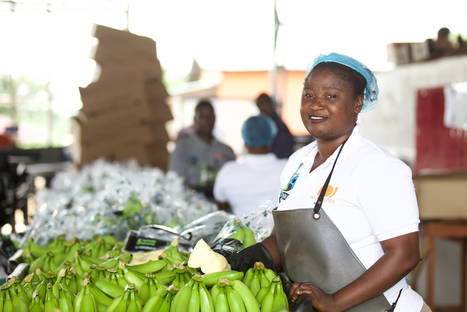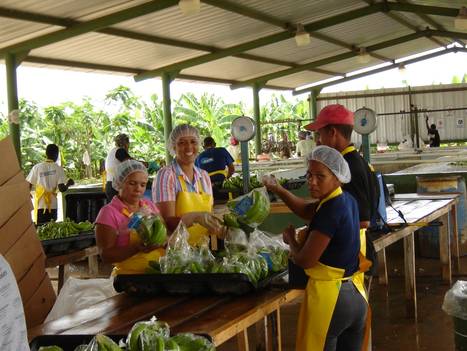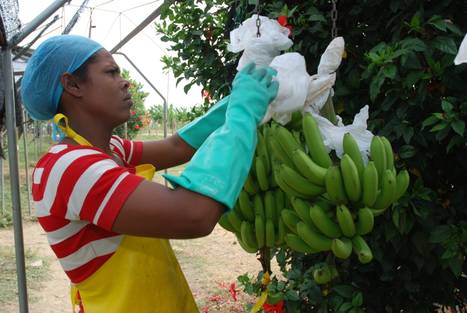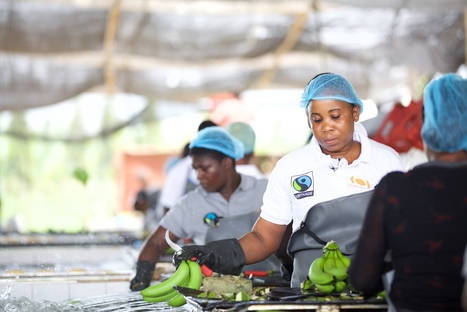Women's employment in the banana industry

Women represent on average 43% of the agricultural workforce in developing countries. In most developing regions, agriculture is the main source of revenue for rural women. However, they typically earn less than men and have less job stability.
In the banana industry, there is a tendency for women to be more represented in smaller scale production for domestic and regional markets while men tend to be more present in large scale banana production for the international export market.
The World Banana Forum Working Group on Gender Equity launched a study in 2014, funded by FAO, to investigate and analyse the diverse levels of women’s employment in the banana export industry in the major production regions of Latin America, the Caribbean and Africa.
It is estimated women represent, on average, less than a fifth of the global workforce in the banana export industry, with the highest participation of women in the banana industry in the Caribbean (excluding the Dominican Republic) where close to 40% of workers and small producers are women.

A historical and cultural analysis reveals a correlation between levels of gender equality in society and levels of women's involvement in the banana industry. Migration is also a factor that explains the differences between countries, as both family responsibilities and the dangers of irregular migration mean women are less likely to migrate to work on banana plantations.
Production tasks considered suitable for women vary considerably between regions, and sometimes between countries within regions. Where small women producers in the Caribbean undertake all tasks involved in production, in Latin America, women's involvement is almost exclusively limited to the packing stations. West and Central Africa falls between these two situations. In the Philippines, women are hired to carry out the same activities as men in the field, although a division of tasks exists in packing houses where they carry out the sorting and handling of the fruit while men apply fungicides and lift heavy loads.
This role division based on gender impacts both women's access to work and is the main factor in the gender pay gap which exists across the industry, where women employees and casual workers consistently earn less than their male co-workers.
The report highlighted the following barriers to women’s employment in the industry:
- low levels of formal education and workplace training;
- restricted roles for women in the workplace (tasks perceived as physically demanding are mostly allocated to male workers);
- employment discrimination (perception of women as ‘high cost’ employees due to company obligations in relation to their reproductive role);
- the burden of the ‘triple day’ (work, household and childcare duties).

However, for the women who do find employment in the banana industry this can provide an important income generation opportunity, especially in banana-dominated communities where alternative employment is hard to find. The employment of women in these areas therefore has an important impact on local socio-economic development (an aspect which requires further investigation).
The WBF report identified the following key issues for women working in the industry.
- Health and safety for women on plantations, especially for pregnant women and nursing mothers.
- Gender-based violence at home, sexual harassment in the workplace.
- Low wages (both due to unequal pay and women typically doing lower paid and more precarious roles).
- Lack of awareness on gender issues and women’s rights issues amongst male colleagues, employers and the wider industry.
- Lack of women representation in decision making platforms, including collective bargaining negotiations and other platforms for negotiation and social dialogue.
The regional reports outline a number of innovations by companies, trade unions and producer associations which could provide some important lessons for the global industry in overcoming the above challenges. These key innovations relate to:
- targeted recruitment campaigns, company policies and clauses in collective agreements to increase women's employment;
- education and training for women workers and their families;
- advances in childcare and breastfeeding provisions;
- healthcare provision for women workers and their families;
- advances for women workers negotiated through collective bargaining;
- gender training and the promotion of women’s leadership;
- company training on topics related to human relations and respectful behaviour in the workplace and policies aimed at ending sexual harassment.
Two industry-level initiatives in particular could provide some learnings on gender :
- The Women’s Committee of the Chiquita/IUF/COLSIBA Regional Agreement, which aims to promote and strengthen a safe working environment (free of harassment, exclusion and inequality), conducive to performance improvements and personal and professional developments for women workers
- The Fairtrade International (FLO) Gender Strategy which aims to use Fairtrade certification as a means to increase women’s employment and Decent Work in the banana and other industries.

Please refer to the Global Overview of the report for further information on the above issues, and subsequent recommendations towards the provision of Decent Work and sustainable livelihoods for women in the global banana industry. These recommendations provide a framework for the ongoing activities of the WBF Working Group on Gender Equity.
References
References
FAO. 2011. Women in agriculture. Closing the gender gap for development
Urocal. 2012. Women’s rights and gender issues for small producers in Ecuador
Peters, K. FAO Gender report Caribbean. Case Study: Windwards Islands small farmers
BananaLink. Support Caribbean Bananas
H.J. Frundt. 2009. Fair Bananas!
BananaLink. Women and the Banana Trade
Chambre d’Agriculture de Côte d’Ivoire website
Fisher, E., Qaim, M., 2012. Gender, Agricultural Commercialization, and Collective Action in Kenya
FAO. Fact Sheet Philippines – Women in Agriculture, Environment and Rural Production
BananaLink. Report on Working Conditions of Female Banana Workers in the Republic of Cameroon
Festagro. Mujeres Bananeras en la Lucha
ILO. 2016. Decent work in global supply chains
Food Empowerment Project. Peeling back the truth on bananas.
World Banana Forum, 2012. Diagnosis on the labour rights situation in the global banana industry: Paper on Discrimination
BananaLink. Social Problems
Cooper, A. 2015. Women in the Banana Export Industry - Global overview (available soon)
CGIAR. 2013. Research Program on Roots, Tubers and Bananas. 2013. Gender Strategy. Version 03
ILO, Decent work in Agriculture, 2003, p. 5
Gender and Law, FAO Legislative study, 76, Rev.1, 2nd edition, p. 124
Festagro. Mujeres Bananeras en la Lucha
IUF. 2015. Empoderando a las Mujeres
Foro Emaus. Health Risks for Women Banana Workers
Ministerio de la Mujer de Republica Dominicana. 2011. Diagnóstico Social de las Mujeres Productoras y Trabajadoras de Banano en las Provincias de Azua, Valverde y Montecristi
ILO. 2012. Freedom of association for women rural workers. A Manual
World Banana Forum. 2014. Labor relations: Successful Cases Within the Banana Industry
Chiquita Brands International. 2012. Corporate Social Responsibility Report

